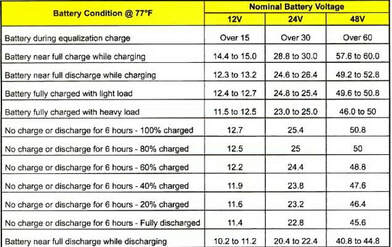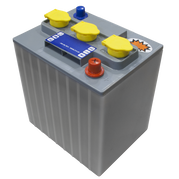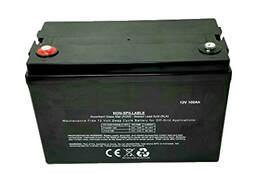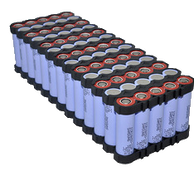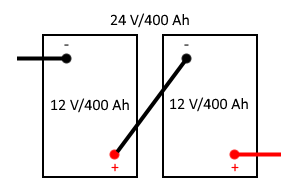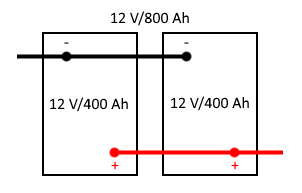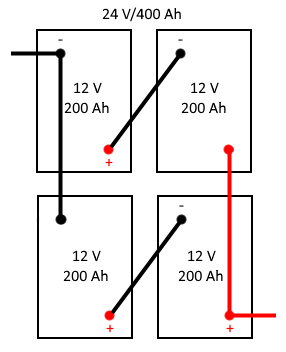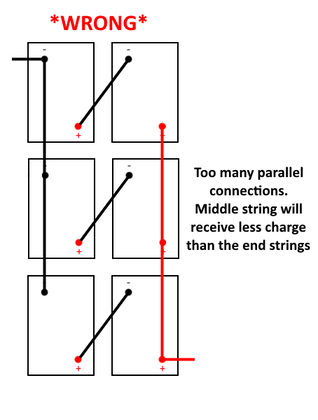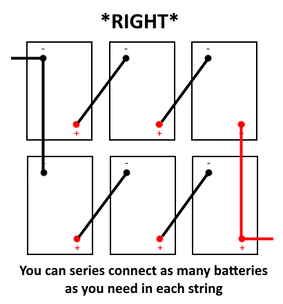Sizing Your Off Grid Battery Bank |
|
Storage Requirements
If you want to take your home or business off the grid, then you're going to need energy storage for the power coming in from your solar PV panels and/or wind turbine. Batteries are the most common method for storing energy, and they come in many types and sizes. Most off grid systems have used either flooded or sealed lead acid batteries. They typically provide the best energy density for the best price, but lately lithium ion battery prices have been decreasing and are becoming more popular as a result because they have a much higher energy density than lead acid batteries. This means that the same amount of energy can be stored in a much smaller space.
The first step in properly sizing your storage system is to determine how much energy you use on a typical day. If you don't already know, then click here to learn how to figure that out. Once you've got that, you then need to decide how many days worth of storage that you want in order to get through each night and back to back days when there's no solar or wind power to harness. For most regions, 2-3 days worth of storage would suffice. For example, if you want to install a solar powered pond aeration system that uses 2 kWh per day (24hrs) and you want 2 days worth of storage for overcast weather, then 2 kWh x 2 days = 4 kWh. So you'll need to be able to store at least 4 kWh.
Sponsored by
Battery Type & Depth Of Discharge
The next step is to decide what you're going to use for batteries. Standard automotive batteries for starting internal combustion engines aren't suitable for this application because they're not designed for constant discharging and charging. They're designed to stay above a certain voltage while the vehicle is operating to keep electrical component functioning with the help of the alternator, and to provide a large instantaneous and short surge of power for starting the vehicle, called cranking amps. For an off grid battery bank, you'll need deep cycle batteries, like what's used in RV's, golf carts, and houseboats, etc. These batteries are designed for constant charging and discharging. Because battery life depends on how many full charge/discharge cycles it goes through (completely drain and recharge), it's recommended to limit the depth of discharge (DOD, ie: how low you drain them) so that the batteries don't go through a complete charge cycle. For lead acid batteries, the recommended DOD limit is ~50%. So if the battery starts out fully charged at 100% capacity and is drained of 50% of its energy before being recharged to full capacity again, then this doesn't count as a full charge cycle and will have a minimal affect on its lifespan. Understanding and applying the recommended DOD means the difference between your batteries lasting only 2 years vs 10 years. The DOD for lithium ion batteries is typically ~75%, so they might be more expensive but they're a bit more forgiving in this regard. For a better understanding of how battery voltage relates to its state of charge, refer to the chart below.
Because the recommended DOD will decrease the amount of energy that can be drawn from a battery, it will have an affect on exactly how much capacity you'll need. Referring back to the 4 kWh battery bank example, if you were to install a 4 kWh lead acid bank to meet your 2 kWh/day demand but can only discharge the batteries to 50%, that means the true capacity of your 4 kWh bank is really only 50% of that amount, 2 kWh. So you'll have to double the bank size to meet your requirements, ie: 4 kWh / 0.5 = 8 kWh total capacity.
If you're using a 75% DOD with a 4 kWh Li-ion bank, then the true capacity would only be 4 x 0.75 = 3 kWh. To get 4 kWh true capacity at 75% DOD, simply divide 4 kWh by 75%:
4 / 0.75 = 5.3 kWh total Li-ion capacity is needed.
If you're using a 75% DOD with a 4 kWh Li-ion bank, then the true capacity would only be 4 x 0.75 = 3 kWh. To get 4 kWh true capacity at 75% DOD, simply divide 4 kWh by 75%:
4 / 0.75 = 5.3 kWh total Li-ion capacity is needed.
Temperature Allowance
We're not quite finished yet. Battery capacity will depend a lot on temperature as well. The above figures are based on batteries stored at room temperature. The colder the environment is that they're located in, the less energy they can store. If your batteries will be installed in a cold environment like a utility shed or unheated garage during the winter, then it would be a good idea to build an insulated box or cabinet to keep them in to help boost their storage capacity. You should aim to keep the space in the battery box above -5°C (23°F) if possible, while allowing ventilation outdoors for any hydrogen gas that might form when the batteries are charging (if they're flooded lead acid). While this will help boost capacity, it's still not as good as storing the batteries at room temperature. So to compensate for the inevitable capacity drop in the cold, you should multiply the total capacity in ideal conditions by 1.5. For example, the 8 kWh/4 kWh @ 50% DOD lead acid battery bank calculated in the previous step would need to be 8 x 1.5 = 12 kWh total capacity to meet the same energy needs if they're stored in a cold environment. If they're going to be stored indoors at or near room temperature, then you don't have to worry. Flooded lead acid batteries will still need to be vented outdoors, however, because they will produce hydrogen gas while charging and it's highly explosive.
Voltage, Amp Hours & Wiring Configuration
Now that you know how to properly calculate capacity requirements, it's time to consider what your storage system voltage will be and figure out the wiring configuration. Small RV systems and camping equipment is typically 12 V. Most larger off grid installations (~500W+) are usually wired for higher voltage for better efficiency, usually 24-48 V. In the case of the solar powered aeration system example, I would opt for a 24V battery bank.
With the system voltage decided, we can determine the total capacity of the battery bank in amp hours to help figure out exactly how many batteries are needed to build the bank. If the bank is built to store 8 kWh of energy at ~24 V, then the total amp hour capacity would need to be: Ah = Wh / V = 8000 / 24 = 333.3 amp hours.
Batteries are made in a range of voltages and amp hr capacities, generally 2 V, 6 V, and 12 V, and from 30 Ah to well over 1000 Ah. Since our pond aerator example calls for a 24V battery bank, that means there are going to be series connections between at least two batteries to increase the voltage. When wiring a battery bank, you can use two different configurations or a combination of both: series and parallel. With a series connection, you wire the negative terminal from one battery to the positive terminal of another battery. This ties them together so that the current flows from one battery to the other in series. This creates a new, larger battery (bank) with the same amp hour capacity as the individual batteries, but twice as much voltage as a whole. For example, if they were rated for 12 V and 200 amp hour each, then the two series connected batteries would still have 200 amp hr of capacity, but at 24 V instead of 12 V. With a parallel connection, you wire the positive terminal from one battery to the + on the other, and the same with the negative terminals. Using the 12 V/200 Ah battery example, when you wire them in parallel and place the leads from a multi-meter on either side of the bank for a voltage reading then it should still say 12 V. But the amp hr capacity doubles from 200 to 400 instead. In either configuration, however, the total watt hour or kWh capacity remains the same. Remember, volts x amps = watts. So 12 V x 400 amp hr = 4800 watt hours (or 4.8 kWh), and 24 V x 200 amp hour still = 4800 watt hours.
With the system voltage decided, we can determine the total capacity of the battery bank in amp hours to help figure out exactly how many batteries are needed to build the bank. If the bank is built to store 8 kWh of energy at ~24 V, then the total amp hour capacity would need to be: Ah = Wh / V = 8000 / 24 = 333.3 amp hours.
Batteries are made in a range of voltages and amp hr capacities, generally 2 V, 6 V, and 12 V, and from 30 Ah to well over 1000 Ah. Since our pond aerator example calls for a 24V battery bank, that means there are going to be series connections between at least two batteries to increase the voltage. When wiring a battery bank, you can use two different configurations or a combination of both: series and parallel. With a series connection, you wire the negative terminal from one battery to the positive terminal of another battery. This ties them together so that the current flows from one battery to the other in series. This creates a new, larger battery (bank) with the same amp hour capacity as the individual batteries, but twice as much voltage as a whole. For example, if they were rated for 12 V and 200 amp hour each, then the two series connected batteries would still have 200 amp hr of capacity, but at 24 V instead of 12 V. With a parallel connection, you wire the positive terminal from one battery to the + on the other, and the same with the negative terminals. Using the 12 V/200 Ah battery example, when you wire them in parallel and place the leads from a multi-meter on either side of the bank for a voltage reading then it should still say 12 V. But the amp hr capacity doubles from 200 to 400 instead. In either configuration, however, the total watt hour or kWh capacity remains the same. Remember, volts x amps = watts. So 12 V x 400 amp hr = 4800 watt hours (or 4.8 kWh), and 24 V x 200 amp hour still = 4800 watt hours.
When it comes to choosing the battery with the right specifications to fit your system, it's best to start by considering a battery with an amp hour rating that's at least half of what's required to build the battery bank if not the full rating, why will be explained later. From our calculations for the pond aerator, we know that we'll need a total of 333.3 Ah at 24 V to get 8 kW (2 days) of energy storage. Let's round that off to 350 Ah, and divide that by 2 = 175 Ah, so an individual battery for the pond aerator bank should have a capacity of at least 175 Ah.
Now we have a couple of choices. For example, the Trojan DC500ML is rated for 12 V and 450 Ah, which is plenty of capacity. In this case, we would just need to series connect two of these batteries together as shown in the image above, and we would have a 24 V/450 Ah, or 10.8 kWh battery bank. More than the 8 kWh that we need. Needing fewer batteries means less connections, so we'll save on wiring and labour costs. But bigger batteries aren't necessarily the most affordable. It's all about the cost/kWh
Another option would be the Surrette Rolls T12-250. It's rated for 12 V and 200 Ah. However, unlike the Trojan battery, we'll need four of the Surrette Rolls to make the same capacity. To increase the voltage we first need to connect the four batteries into two separate groups of two series connected batteries. Each group is called a string, and the series connections will double the voltage from 12 to 24 V. The next step is to connect each string in parallel to double the amp hour capacity from 200 to 400 for the entire bank.
Now we have a couple of choices. For example, the Trojan DC500ML is rated for 12 V and 450 Ah, which is plenty of capacity. In this case, we would just need to series connect two of these batteries together as shown in the image above, and we would have a 24 V/450 Ah, or 10.8 kWh battery bank. More than the 8 kWh that we need. Needing fewer batteries means less connections, so we'll save on wiring and labour costs. But bigger batteries aren't necessarily the most affordable. It's all about the cost/kWh
Another option would be the Surrette Rolls T12-250. It's rated for 12 V and 200 Ah. However, unlike the Trojan battery, we'll need four of the Surrette Rolls to make the same capacity. To increase the voltage we first need to connect the four batteries into two separate groups of two series connected batteries. Each group is called a string, and the series connections will double the voltage from 12 to 24 V. The next step is to connect each string in parallel to double the amp hour capacity from 200 to 400 for the entire bank.
Remember when I said that the amp hr rating for an individual battery should be half of the total needed? If it ends up being less than half, then we would need to connect more than two strings in parallel. This should be avoided at all cost, because the middle strings won't receive the same amount of charge or discharge as the strings on the ends of the bank, which will make the bank less dependable and cause the batteries to expire at different rates.
20 Hour Rate Vs 100 Hour RateOne more thing to consider is the amp hour discharge rate of the battery, which will determine how heavy of a load you can put on it and still get the rated capacity - the harder you work the battery, the less total amount of energy that will be available to you. Manufacturers offer two options to help compensate, 100 hour discharge rate vs 20 hour discharge rate. So if a battery is rated for 400 Ah @ 100 hours, that means you can expect to get the full 400 Ah by pulling 4 amps from it for 100 hours: 400 / 100 = 4. If the battery is rated for 400 Ah @ 20 hours, that means you can expect to get the full 400 Ah by pulling 20 amps for 20 hours: 400 / 20 = 20. In other words, if you try to pull 20+ amps continuously from the 100 hour battery, then you won't get the full 400 amp hours out of it. But generally, off grid systems utilize batteries with the 100 hour rating because they're usually more affordable and the bank capacity is large enough to accommodate a heavy load without working each individual battery too hard and lowering it's capacity exponentially - the current draw is split throughout the bank, so the more batteries there are then the less current each one has to output to meet the demand.
That's it. That's all you need to know to arm yourself when you go shopping for batteries for your off grid system. Again, batteries come in all different types and sizes. Your battery bank is just as if not more important than your panels or turbine. You can lose your array but still have uninterrupted power coming from the batteries, and use your back up petrol generator to top it up if/when needed. If you lose your battery bank, however, then you'll be relying solely on your back up generator. So take your time to do the math and get it right. |
|


